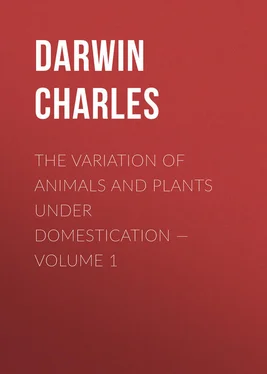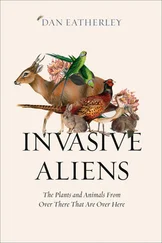Charles Darwin - The Variation of Animals and Plants under Domestication — Volume 1
Здесь есть возможность читать онлайн «Charles Darwin - The Variation of Animals and Plants under Domestication — Volume 1» — ознакомительный отрывок электронной книги совершенно бесплатно, а после прочтения отрывка купить полную версию. В некоторых случаях можно слушать аудио, скачать через торрент в формате fb2 и присутствует краткое содержание. Жанр: foreign_antique, foreign_prose, на английском языке. Описание произведения, (предисловие) а так же отзывы посетителей доступны на портале библиотеки ЛибКат.
- Название:The Variation of Animals and Plants under Domestication — Volume 1
- Автор:
- Жанр:
- Год:неизвестен
- ISBN:нет данных
- Рейтинг книги:5 / 5. Голосов: 1
-
Избранное:Добавить в избранное
- Отзывы:
-
Ваша оценка:
- 100
- 1
- 2
- 3
- 4
- 5
The Variation of Animals and Plants under Domestication — Volume 1: краткое содержание, описание и аннотация
Предлагаем к чтению аннотацию, описание, краткое содержание или предисловие (зависит от того, что написал сам автор книги «The Variation of Animals and Plants under Domestication — Volume 1»). Если вы не нашли необходимую информацию о книге — напишите в комментариях, мы постараемся отыскать её.
The Variation of Animals and Plants under Domestication — Volume 1 — читать онлайн ознакомительный отрывок
Ниже представлен текст книги, разбитый по страницам. Система сохранения места последней прочитанной страницы, позволяет с удобством читать онлайн бесплатно книгу «The Variation of Animals and Plants under Domestication — Volume 1», без необходимости каждый раз заново искать на чём Вы остановились. Поставьте закладку, и сможете в любой момент перейти на страницу, на которой закончили чтение.
Интервал:
Закладка:
All naturalists, with, as far as I know, a single exception, believe that the several domestic breeds of the rabbit are descended from the common wild species; I shall therefore describe them more carefully than in the previous cases. Professor Gervais (4/1. M.P. Gervais 'Hist. Nat. des Mammiferes' 1854. tome 1 page 288.) states "that the true wild rabbit is smaller than the domestic; its proportions are not absolutely the same; its tail is smaller; its ears are shorter and more thickly clothed with hair; and these characters, without speaking of colour, are so many indications opposed to the opinion which unites these animals under the same specific denomination." Few naturalists will agree with this author that such slight differences are sufficient to separate as distinct species the wild and domestic rabbit. How extraordinary it would be, if close confinement, perfect tameness, unnatural food, and careful breeding, all prolonged during many generations, had not produced at least some effect! The tame rabbit has been domesticated from an ancient period. Confucius ranges rabbits among animals worthy to be sacrificed to the gods, and, as he prescribes their multiplication, they were probably at this early period domesticated in China. They are mentioned by several of the classical writers. In 1631 Gervaise Markham writes, "You shall not, as in other cattell, looke to their shape, but to their richnesse, onely elect your buckes, the largest and goodliest conies you can get; and for the richnesse of the skin, that is accounted the richest which hath the equallest mixture of blacke and white haire together, yet the blacke rather shadowing the white; the furre should be thicke, deepe, smooth, and shining;...they are of body much fatter and larger, and, when another skin is worth two or three pence, they are worth two shillings." From this full description we see that silver-grey rabbits existed in England at this period; and what is far more important, we see that the breeding or selection of rabbits was then carefully attended to. Aldrovandi, in 1637, describes, on the authority of several old writers (as Scaliger, in 1557), rabbits of various colours, some "like a hare," and he adds that P. Valerianus (who died a very old man in 1558) saw at Verona rabbits four times bigger than ours. (4/2. U. Aldrovandi 'De Quadrupedibus digitatis' 1637 page 383. For Confucius and G. Markham see a writer who has studied the subject in 'Cottage Gardener' January 22, 1861 page 250.)
From the fact of the rabbit having been domesticated at an ancient period, we must look to the northern hemisphere of the Old World, and to the warmer temperate regions alone, for the aboriginal parent-form; for the rabbit cannot live without protection in countries as cold as Sweden, and, though it has run wild in the tropical island of Jamaica, it has never greatly multiplied there. It now exists, and has long existed, in the warmer temperate parts of Europe, for fossil remains have been found in several countries. (4/3. Owen 'British Fossil Mammals' page 212.) The domestic rabbit readily becomes feral in these same countries, and when variously coloured kinds are turned out they generally revert to the ordinary grey colour. (4/4. Bechstein 'Naturgesch. Deutschlands' 1801 b. 1 page 1133. I have received similar accounts with respect to England and Scotland.) Wild rabbits, if taken young, can be domesticated, though the process is generally very troublesome. (4/5. 'Pigeons and Rabbits' by E.S. Delamer 1854 page 133. Sir J. Sebright 'Observations on Instinct' 1836 page 10) speaks most strongly on the difficulty. But this difficulty is not invariable, as I have received two accounts of perfect success in taming and breeding from the wild rabbit. See also Dr. P. Broca in 'Journal de la Physiologie' tome 2 page 368.) The various domestic races are often crossed, and are believed to be quite fertile together, and a perfect gradation can be shown to exist from the largest domestic kinds, having enormously developed ears, to the common wild kind. The parent-form must have been a burrowing animal, a habit not common, as far as I can discover, to any other species in the large genus Lepus. Only one wild species is known with certainty to exist in Europe; but the rabbit (if it be a true rabbit) from Mount Sinai, and likewise that from Algeria, present slight differences; and these forms have been considered by some authors as specifically distinct. (4/6. Gervais 'Hist. Nat. des Mammiferes' tome 1 page 292.) But such slight differences would aid us little in explaining the more considerable differences characteristic of the several domestic races. If the latter are the descendants of two or more closely allied species, these, with the exception of the common rabbit, have been exterminated in a wild state; and this is very improbable, seeing with what pertinacity this animal holds its ground. From these several reasons we may infer with safety that all the domestic breeds are the descendants of the common wild species. But from what we hear of the marvellous success in France in rearing hybrids between the hare and rabbit (4/7. See Dr. P. Broca's interesting memoir on this subject in Brown-Sequard 'Journ. de. Phys.' volume 2 page 367.), it is possible, though not probable, from the great difficulty in making the first cross, that some of the larger races, which are coloured like the hare, may have been modified by crosses with this animal. Nevertheless, the chief differences in the skeletons of the several domestic breeds cannot, as we shall presently see, have been derived from a cross with the hare.
There are many breeds which transmit their characters more or less truly. Every one has seen the enormous lop-eared rabbits exhibited at our shows; various allied sub-breeds are reared on the Continent, such as the so- called Andalusian, which is said to have a large head with a round forehead, and to attain a greater size than any other kind; another large Paris breed is named the Rouennais, and has a square head; the so-called Patagonian rabbit has remarkably short ears and a large round head. Although I have not seen all these breeds, I feel some doubt about there being any marked difference in the shape of their skulls. (4/8. The skulls of these breeds are briefly described in the 'Journal of Horticulture' May 7, 1861 page 108.) English lop-eared rabbits often weigh 8 pounds or 10 pounds, and one has been exhibited weighing 18 pounds; whereas a full-sized wild rabbit weighs only about 3 1/4 pounds. The head or skull in all the large lop-eared rabbits examined by me is much longer relatively to its breadth than in the wild rabbit. Many of them have loose transverse folds of skin or dewlaps beneath the throat, which can be pulled out so as to reach nearly to the ends of the jaws. Their ears are prodigiously developed, and hang down on each side of their faces. A rabbit was exhibited in 1867 with its two ears, measured from the tip of one to the tip of the other, 22 inches in length, and each ear 5 3/8 inches in breadth. In 1869 one was exhibited with ears, measured in the same manner, 23 1/8 in length and 5 1/2 in breadth; "thus exceeding any rabbit ever exhibited at a prize show." In a common wild rabbit I found that the length of two ears, from tip to tip, was 7 5/8 inches, and the breadth only 1 7/8 inch. The weight of body in the larger rabbits, and the development of their ears, are the qualities which win prizes, and have been carefully selected.
The hare-coloured, or, as it is sometimes called, the Belgian rabbit, differs in nothing except colour from the other large breeds; but Mr. J. Young, of Southampton, a great breeder of this kind, informs me that the females, in all the specimens examined by him, had only six mammae; and this certainly was the case with two females which came into my possession. Mr. B.P. Brent, however, assures me that the number is variable with other domestic rabbits. The common wild rabbit always has ten mammae. The Angora rabbit is remarkable from the length and fineness of its fur, which even on the soles of the feet is of considerable length. This breed is the only one which differs in its mental qualities, for it is said to be much more sociable than other rabbits, and the male shows no wish to destroy its young. (4/9. 'Journal of Horticulture' 1861 page 380.) Two live rabbits were brought to me from Moscow, of about the size of the wild species, but with long soft fur, different from that of the Angora. These Moscow rabbits had pink eyes and were snow-white, excepting the ears, two spots near the nose, the upper and under surface of the tail, and the hinder tarsi, which were blackish-brown. In short, they were coloured nearly like the so-called Himalayan rabbits, presently to be described, and differed from them only in the character of their fur. There are two other breeds which come true to colour, but differ in no other respect, namely silver-greys and chinchillas. Lastly, the Nicard or Dutch rabbit may be mentioned, which varies in colour, and is remarkable from its small size, some specimens weighing only 1 1/4 pounds; rabbits of this breed make excellent nurses for other and more delicate kinds. (4/10. 'Journal of Horticulture' May 28, 1861 page 169.)
Читать дальшеИнтервал:
Закладка:
Похожие книги на «The Variation of Animals and Plants under Domestication — Volume 1»
Представляем Вашему вниманию похожие книги на «The Variation of Animals and Plants under Domestication — Volume 1» списком для выбора. Мы отобрали схожую по названию и смыслу литературу в надежде предоставить читателям больше вариантов отыскать новые, интересные, ещё непрочитанные произведения.
Обсуждение, отзывы о книге «The Variation of Animals and Plants under Domestication — Volume 1» и просто собственные мнения читателей. Оставьте ваши комментарии, напишите, что Вы думаете о произведении, его смысле или главных героях. Укажите что конкретно понравилось, а что нет, и почему Вы так считаете.












